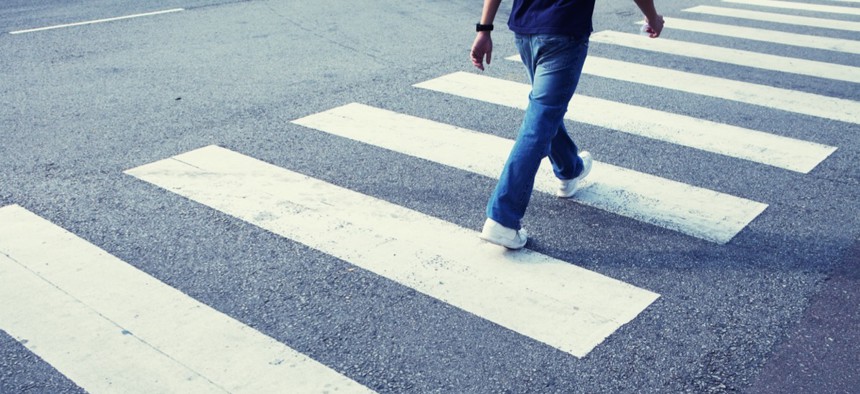More Pedestrians Are Getting Killed By Cars

Better street design—narrower lanes, more foliage—could help combat the problem, researchers said. iStock.com/Entienou
The number of pedestrians struck and killed is up 45% over the last decade. People of color and residents of low-income and rural communities are more at risk, according to new research.
The number of pedestrians struck and killed by cars and other motor vehicles in the United States each year has increased by 45% in the past decade, a “preventable crisis” that could be halted by policy interventions at the federal, state and local levels, according to research released this week.
“Our current approach to addressing these deaths needs to be reconsidered or dropped altogether—it is not working,” says the Dangerous By Design report, an annual analysis from Smart Growth America and the National Complete Streets Coalition. “States and localities cannot simply deploy the same playbook and expect this trend to change—they need a fundamentally different approach.”
The report examines nationwide pedestrian deaths between 2010 and 2019, when 53,435 people were struck and killed by vehicles on roadways—an average of 14 per day. More than 6,200 people were killed by cars in both 2018 and 2019, the highest numbers of pedestrian deaths since 1990—despite an overall decrease in the number of people walking to work, according to the data.
Other research on pedestrian deaths in recent years has reached similar conclusions. The data in this latest report is from before the coronavirus pandemic struck early last year, upending daily life and leading to declines in traffic in many places as legions of Americans switched to remote work and stopped commuting.
The risks to pedestrians aren't spread equally across demographic groups, the report found—older adults, people of color, residents of low-income communities and people in rural areas were more likely to be struck and killed by cars.
There are varying reasons for that discrepancy, the report noted.
Low-income households, for example, “are significantly less likely to have access to a vehicle and also less likely to live in communities where they can reach daily needs safely and affordably outside a car.”
Structural racism and implicit bias also contribute to the disparities, both in terms of policy decisions and individual behavior (studies have found, for example, that drivers are more likely to yield to a white pedestrian in a crosswalk than to a Black one).
“Though people of all ages, races, ethnicities, and income levels suffer the consequences of dangerous street design, some neighborhoods and groups of people bear a larger share of the burden,” the report said.
Regionally, Southern states tend to be the most deadly for pedestrians, according to the report’s Pedestrian Danger Index, which calculates danger based on the number of people killed by drivers compared to population and the number of people walking.
Florida is the worst, followed by Alabama, New Mexico, Mississippi, Delaware and Louisiana. Seventeen of the 20 most dangerous metro areas are also in the South, and nine of those 20 are in Florida, including the Orlando-Kissimmee-Sanford area, ranked first on the list.
“Much of the growth and development in southern states occurred after World War II as car ownership became widespread, and those states still face that legacy today in the form of spread out, driving-scale development with wider roads and long blocks,” the report said. “Those conditions make it more dangerous to travel outside a car and more difficult to make design changes that improve safety.”
The report claims that changes in road design could drastically improve safety for people on foot, particularly designs that use visual cues to encourage slower speeds. Wide lanes, for example, “encourage mistakes” and faster driving, while adding foliage to curbs and medians can prompt drivers to slow down, according to Beth Osborne, director of transportation for Smart Growth America.
“Trees and bushes can make you feel a little more closed in,” Osborne said on a media call Tuesday. “When you feel like you’re in a tighter area, the driver is going to naturally decide to go slower because they don’t feel like they have as much room to maneuver.”
Lower speed limits can help, she added, but aren’t enough on their own to make up for design features that encourage faster driving. “The speed limit alone can’t change the fact that a road is communicating to the driver that they can go as fast as they wish,” she said.
To address the problem, the report recommended that state and local lawmakers “prioritize projects that bring the greatest benefits to those who are suffering disproportionately,” including low-income communities and people of color.
Lawmakers should also reassess funding and infrastructure policies to ensure that “departments of transportation...consistently plan for and construct projects for all people who use the street, including the most vulnerable,” the report concluded.
Kate Elizabeth Queram is a staff correspondent for Route Fifty and is based in Washington, D.C.
NEXT STORY: Alaska Becomes First State to End Restrictions on Vaccine Eligibility





